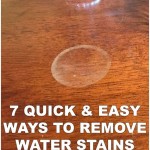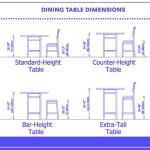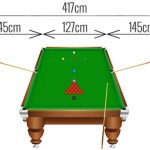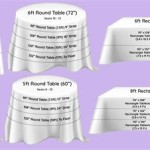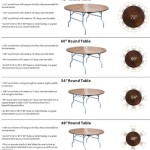How To Remove Old Water Stains From Wood Table Top
Water stains on wood table tops, often appearing as rings or cloudiness, are a common nuisance. These blemishes result from moisture penetrating the finish and becoming trapped beneath, affecting the wood itself. Successfully removing these stains requires understanding the nature of the stain, the type of finish on the wood, and employing appropriate techniques to lift the trapped moisture and restore the wood's appearance. Various methods exist, ranging from gentle home remedies to more intensive refinishing options.
Before attempting any stain removal technique, it is crucial to identify the type of finish protecting the wood. Common finishes include lacquer, varnish, polyurethane, shellac, and wax. Determining the finish can inform the selection of cleaning agents and techniques, preventing further damage to the wood. A simple test involves applying a small amount of denatured alcohol to an inconspicuous area. If the finish dissolves or becomes sticky, it is likely shellac or lacquer. Polyurethane and varnish are more resistant to denatured alcohol.
Once the finish is identified, the severity of the water stain should be evaluated. Light stains, often characterized as a hazy appearance, typically indicate that moisture is trapped only within the finish layer. Deeper, darker stains suggest that the moisture has penetrated the wood itself. The chosen removal method will depend on the depth and severity of the stain.
Key Point 1: Gentle Heat Application
Applying gentle heat is a frequently recommended initial approach for removing water stains trapped within the finish. The heat aids in drawing the trapped moisture out of the finish, allowing it to evaporate. This method is most effective for relatively recent and superficial water stains.
A common technique involves using a household iron, set to a low or medium setting, with the steam function turned off. A clean, dry cloth, preferably cotton, should be placed over the water stain to protect the finish from direct heat exposure. The iron is then gently pressed onto the cloth, moved in small circular motions, for short intervals of approximately 10-15 seconds. The process should be repeated several times, carefully monitoring the stain's progress. Avoid overheating the area, as excessive heat can damage the finish or the wood.
An alternative heat source is a hairdryer. Setting the hairdryer to a low heat setting and directing the airflow towards the stain, while maintaining a distance of several inches, can also be effective. The hairdryer should be moved back and forth across the stain to ensure even heat distribution. The same precautionary measures as with an iron apply – avoid overheating and monitor the stain’s progress closely.
Following heat application, it is advisable to apply a furniture polish or wax to the treated area. This helps to restore the sheen and protect the finish. The polishing should be done according to the manufacturer's instructions for the specific polish or wax being used.
Key Point 2: Using Absorbent Materials and Gentle Abrasives
Another category of stain removal techniques involves using absorbent materials to draw moisture from the wood or gentle abrasives to remove the affected layer of the finish. These methods require careful application to avoid damaging the underlying wood.
One common approach utilizes a paste made from baking soda and water. A small amount of baking soda is mixed with water to create a thick paste. This paste is then gently applied to the water stain and left to sit for approximately 30 minutes. The baking soda acts as a mild abrasive and absorbent, helping to lift the moisture and stain from the finish. After 30 minutes, the paste is carefully wiped away with a damp cloth, and the area is dried thoroughly. This process may need to be repeated multiple times for stubborn stains.
Toothpaste, specifically non-gel varieties, can also be used in a similar manner. The toothpaste is applied to the stain, allowed to sit for a short period (5-10 minutes), and then gently rubbed in a circular motion with a soft cloth. The mild abrasive qualities of the toothpaste can help to remove the stain. After rubbing, the area is cleaned with a damp cloth and dried thoroughly.
Another absorbent material that can be used is salt. A thin layer of salt is sprinkled over the water stain, and a clean, dry cloth is placed over the salt. The cloth is then gently pressed onto the salt, allowing it to absorb the moisture. This method is best suited for fresh water stains.
For more stubborn stains, a mixture of olive oil and salt can be used. The abrasive action of the salt combined with the oil’s lubricating properties can help to remove the stain without scratching the finish. The mixture is applied to the stain, gently rubbed in a circular motion, and then wiped away with a clean cloth.
It is crucial to test any abrasive method on an inconspicuous area of the wood table top before applying it to the water stain. This ensures that the method does not damage the finish or leave behind any unwanted marks.
Key Point 3: Refinishing the Wood Table Top
If the water stains are deep and persistent, and the previously mentioned methods have proven ineffective, refinishing the wood table top may be necessary. Refinishing involves removing the existing finish, sanding the wood to remove the stain, and applying a new finish. This is a more involved process that requires skill and patience.
The first step in refinishing is to remove the old finish. This can be done using a chemical stripper designed for wood finishes. The stripper should be applied according to the manufacturer's instructions, typically involving brushing it onto the surface and allowing it to sit for a specified period. The softened finish can then be scraped away using a putty knife or scraper. Multiple applications of the stripper may be necessary to remove all of the old finish.
Once the old finish is removed, the wood needs to be sanded to remove any remaining stain and create a smooth surface for the new finish. Sanding should begin with a coarse grit sandpaper (e.g., 80-grit) to remove the bulk of the stain and imperfections. Subsequent sanding should be done with progressively finer grits (e.g., 120-grit, 220-grit) to achieve a smooth, even surface. It is essential to sand in the direction of the wood grain to avoid scratching the wood.
After sanding, the wood should be thoroughly cleaned to remove any sanding dust. A tack cloth or a damp cloth can be used for this purpose. The wood needs to be completely dry before applying the new finish.
The final step is to apply a new finish to the wood table top. The choice of finish depends on the desired appearance and level of protection. Common options include polyurethane, varnish, lacquer, and shellac. Polyurethane is a durable and water-resistant finish that is suitable for high-use surfaces. Varnish provides a similar level of protection and is available in various sheens. Lacquer dries quickly and provides a smooth, hard finish. Shellac is a more traditional finish that is easy to apply but less durable than polyurethane or varnish.
The finish should be applied according to the manufacturer's instructions, typically involving applying multiple thin coats with a brush, roller, or sprayer. Each coat should be allowed to dry completely before applying the next. Light sanding between coats can help to create a smoother finish. The final coat should be allowed to dry for several days before the table top is put back into use.
Refinishing a wood table top is a significant undertaking, and it is important to carefully consider whether it is the right solution for the specific situation. If the water stains are relatively minor, it may be possible to remove them using less invasive methods. However, if the stains are deep and persistent, refinishing may be the only way to restore the table top to its original beauty.
Regardless of the method employed, patience and careful application are key to successfully removing water stains from a wood table top. Always test any cleaning or refinishing product in an inconspicuous area first to ensure it does not damage the finish or wood. Proper preparation and attention to detail will yield the best results and help to preserve the beauty and longevity of the wood furniture.

How To Remove Water Stains From Wood Use This Viral

The Easiest Way To Remove Water Stains From Wood Exquisitely Unremarkable

How To Remove Water Stains From Wood Furniture Bona Com

Removing Water Spots From A Finish The Wood Whisperer

How To Remove Watermarks Popular Woodworking
5 Quick And Easy Ways To Remove Water Stains From Wood

Why Removing Water Stains From Wood Is Easy

How Do I Remove Water Spots From A Veneer Table Top Hometalk

How To Remove Water Stains From Wood Sometimes Homemade

How About Orange Experiment Mayonnaise To Treat Water Stains

